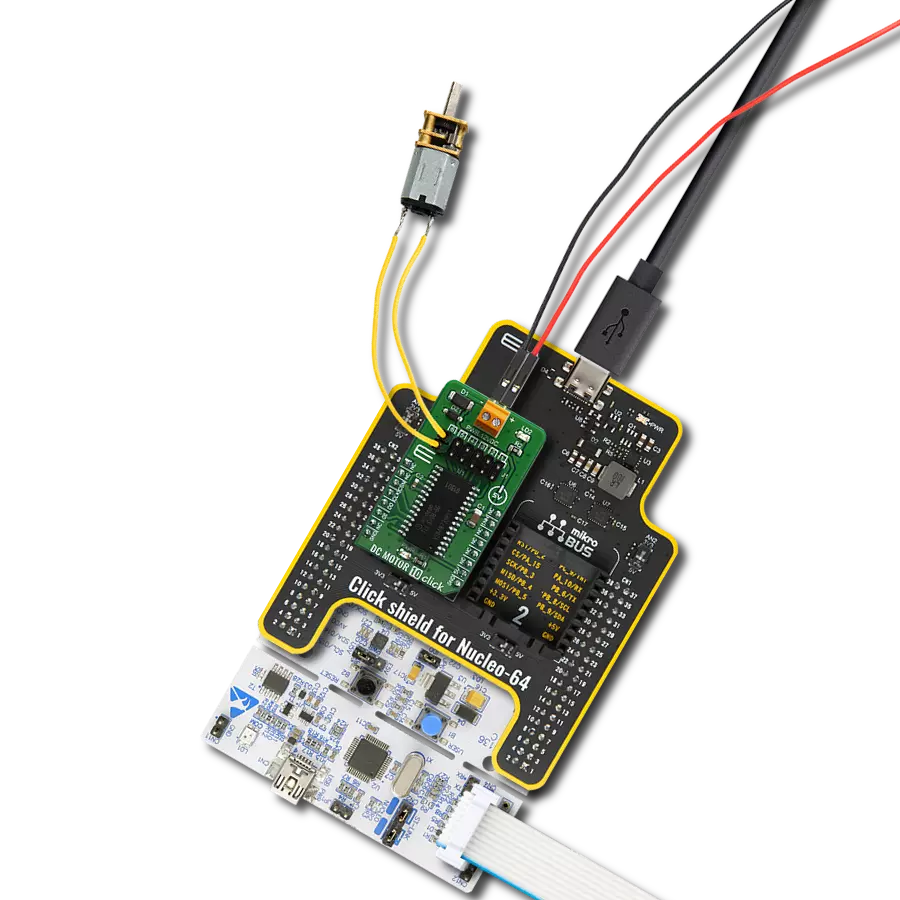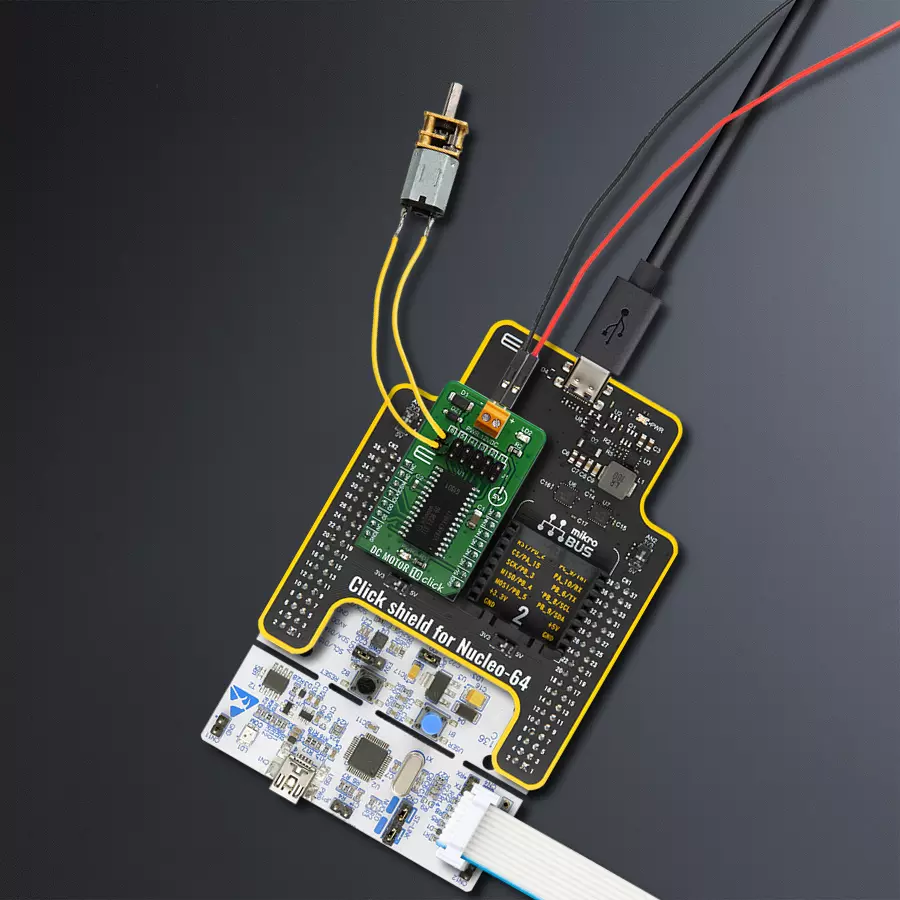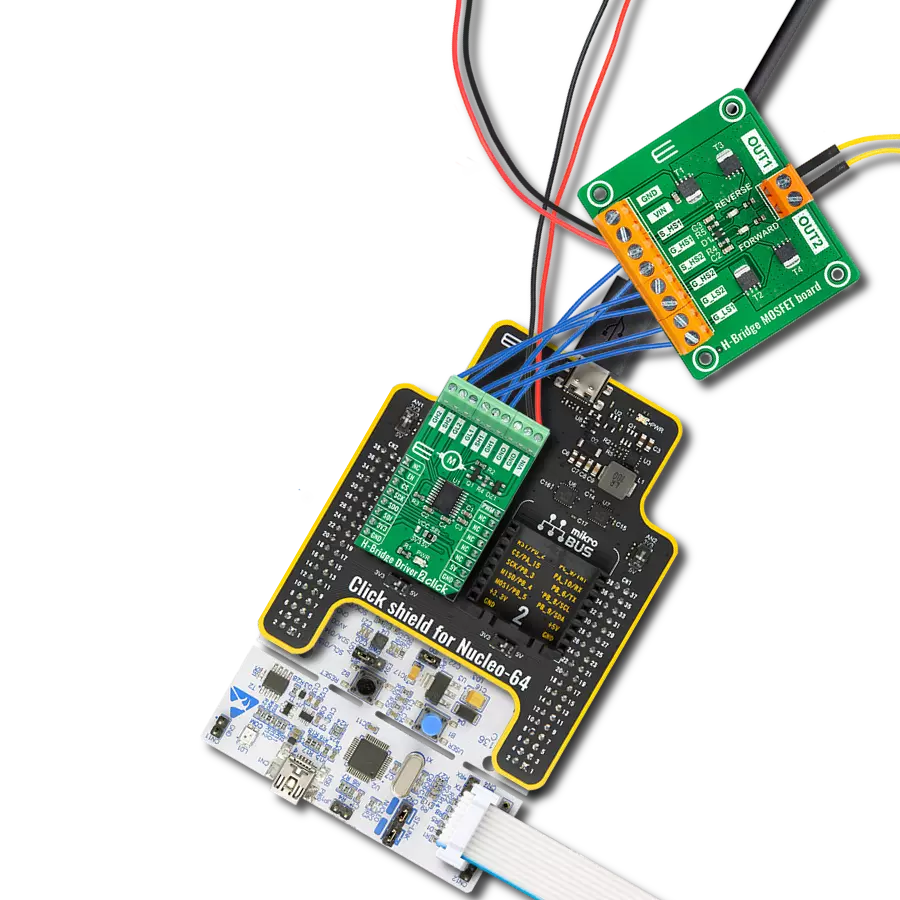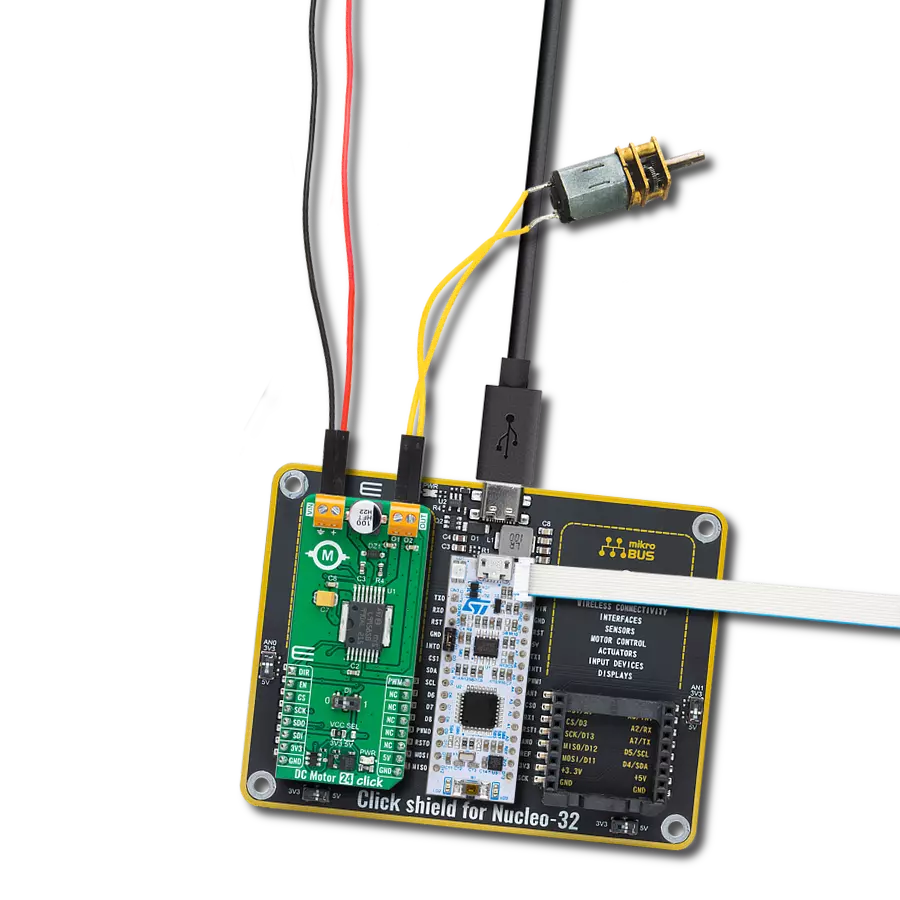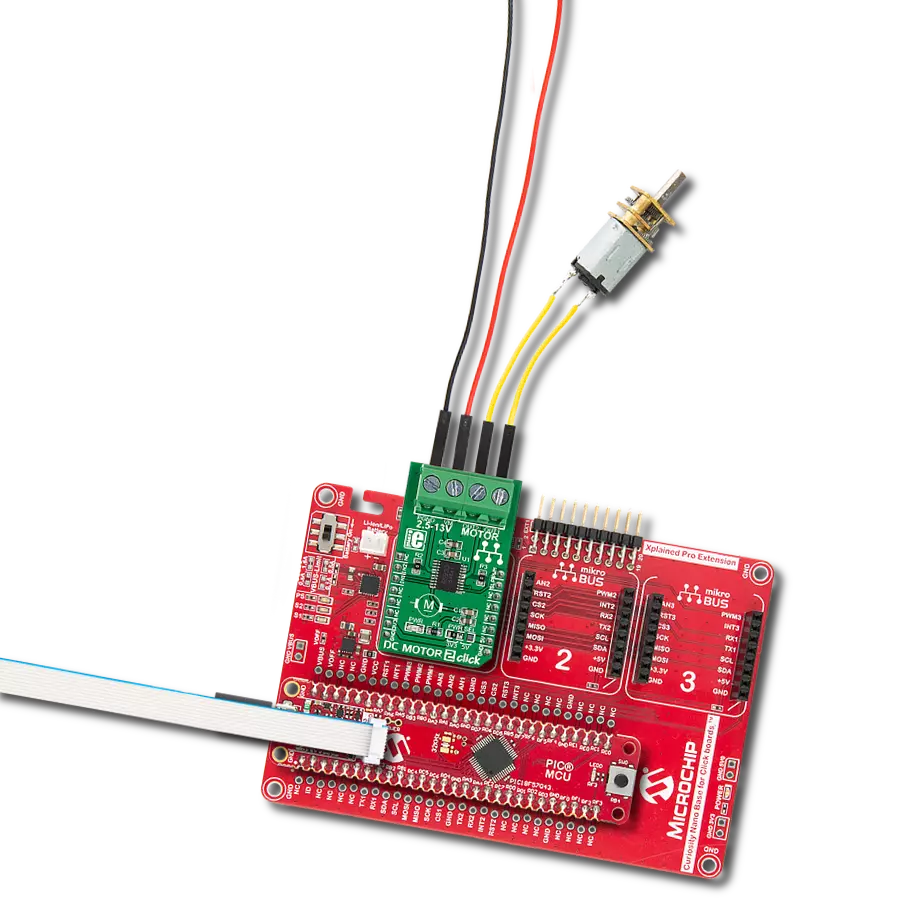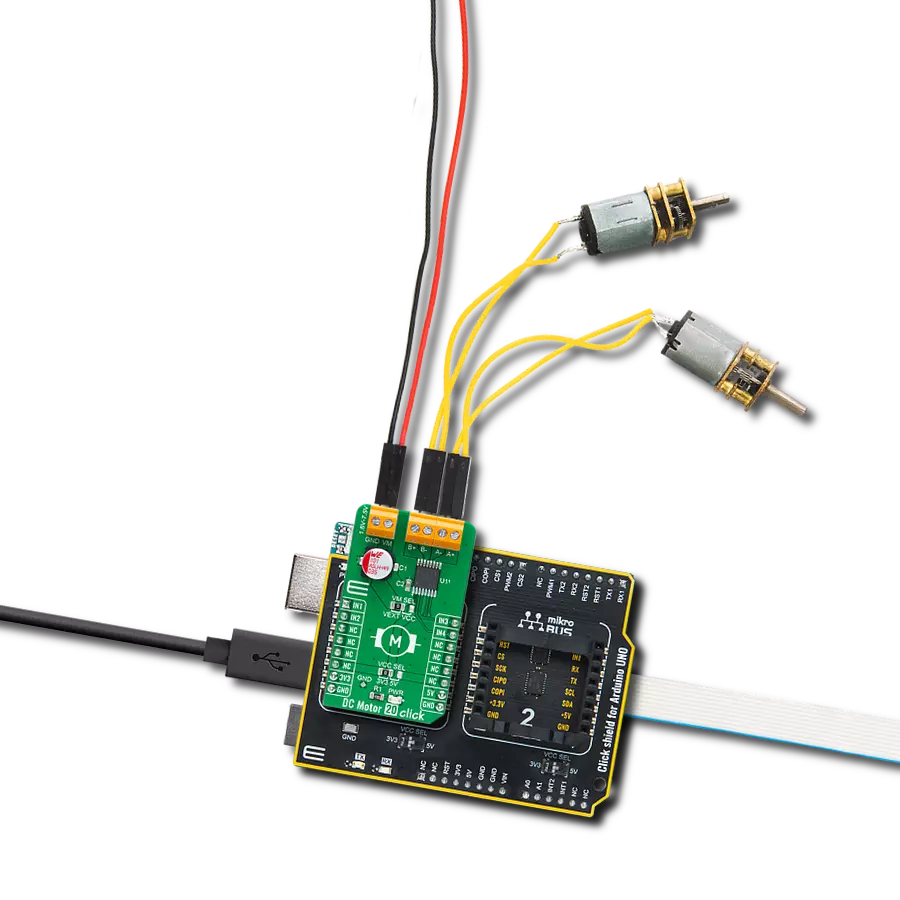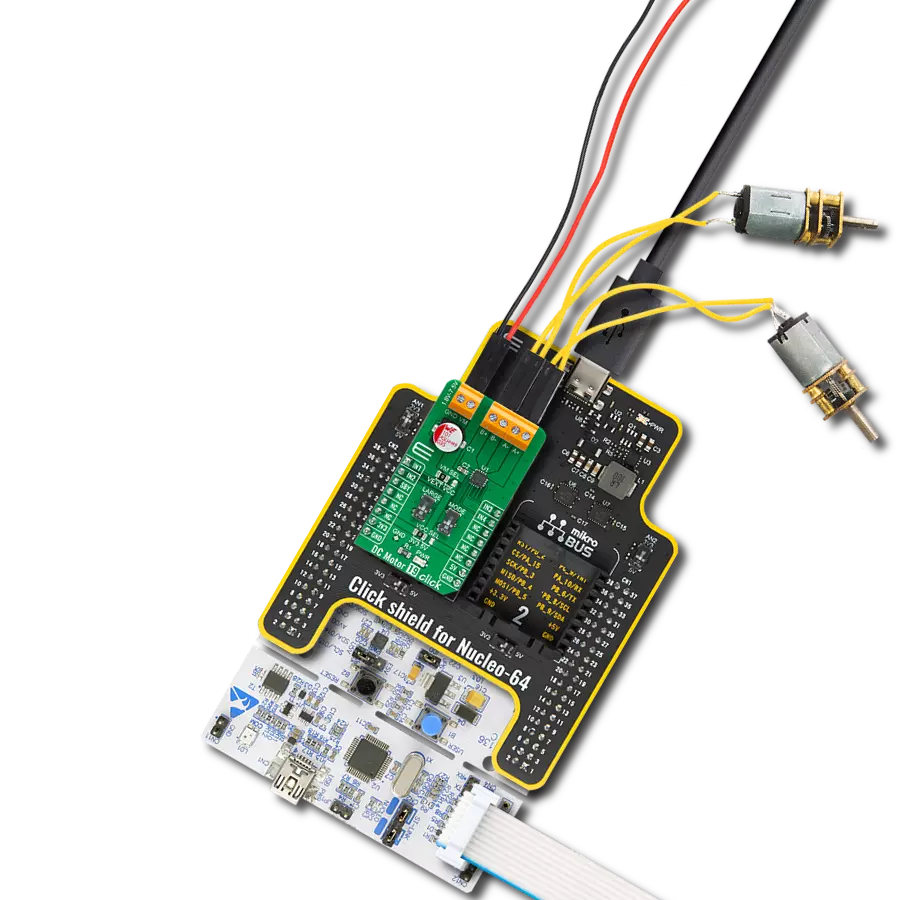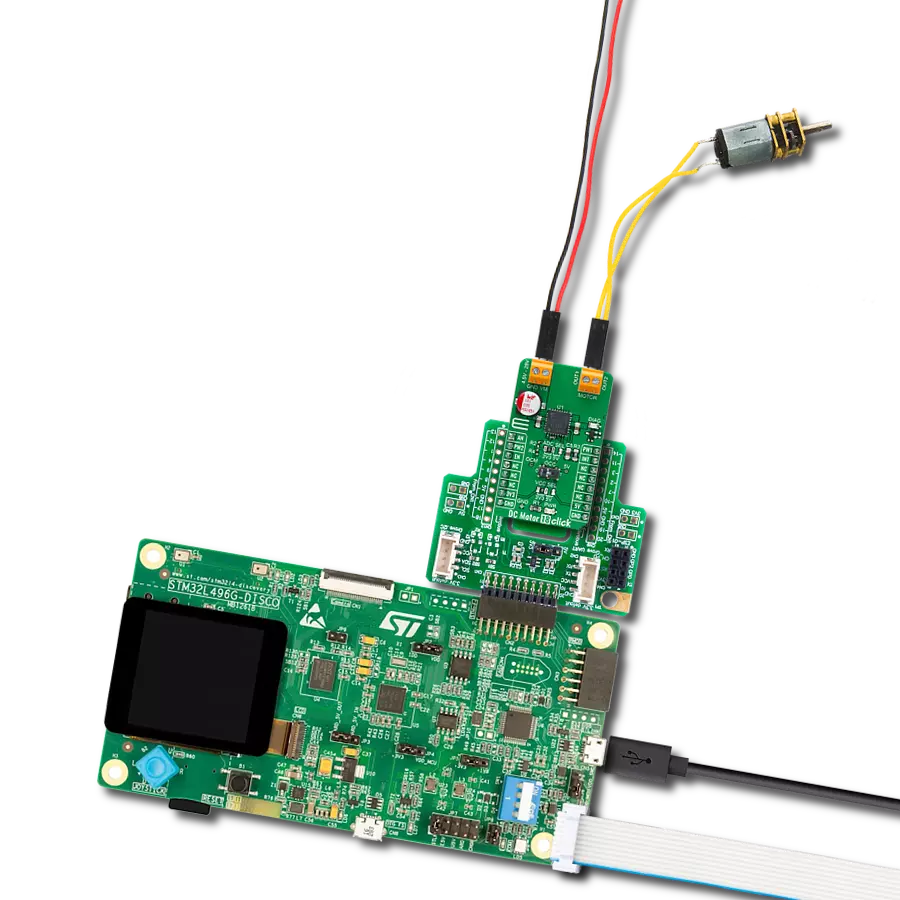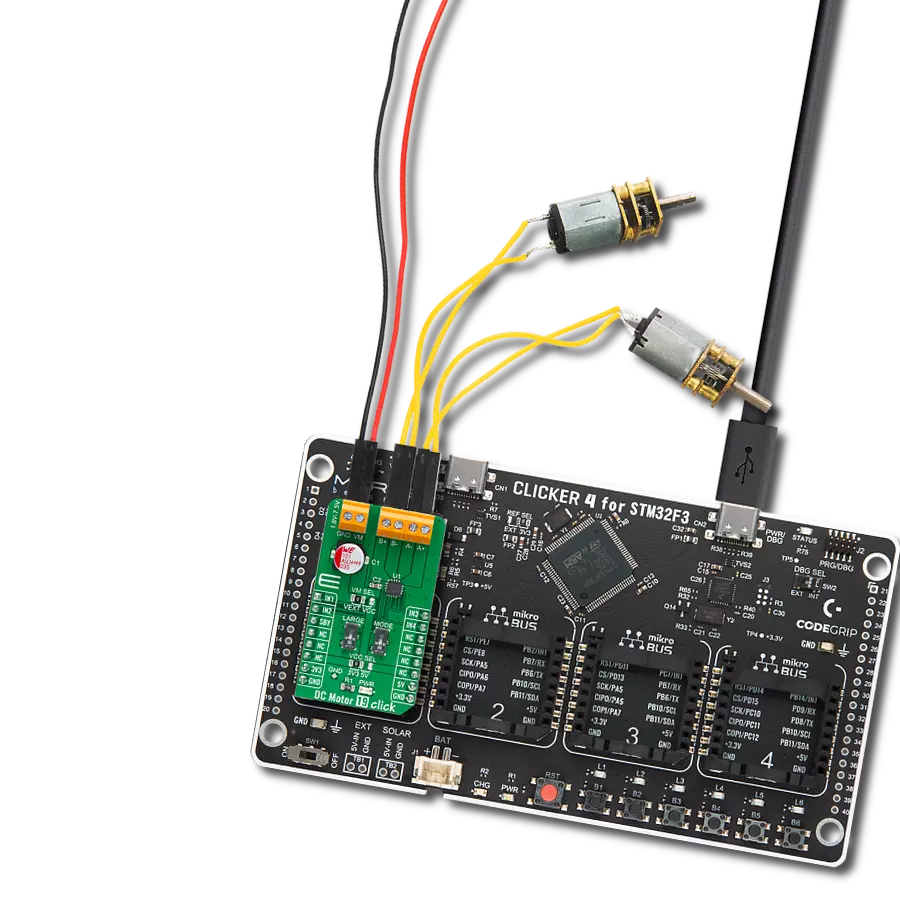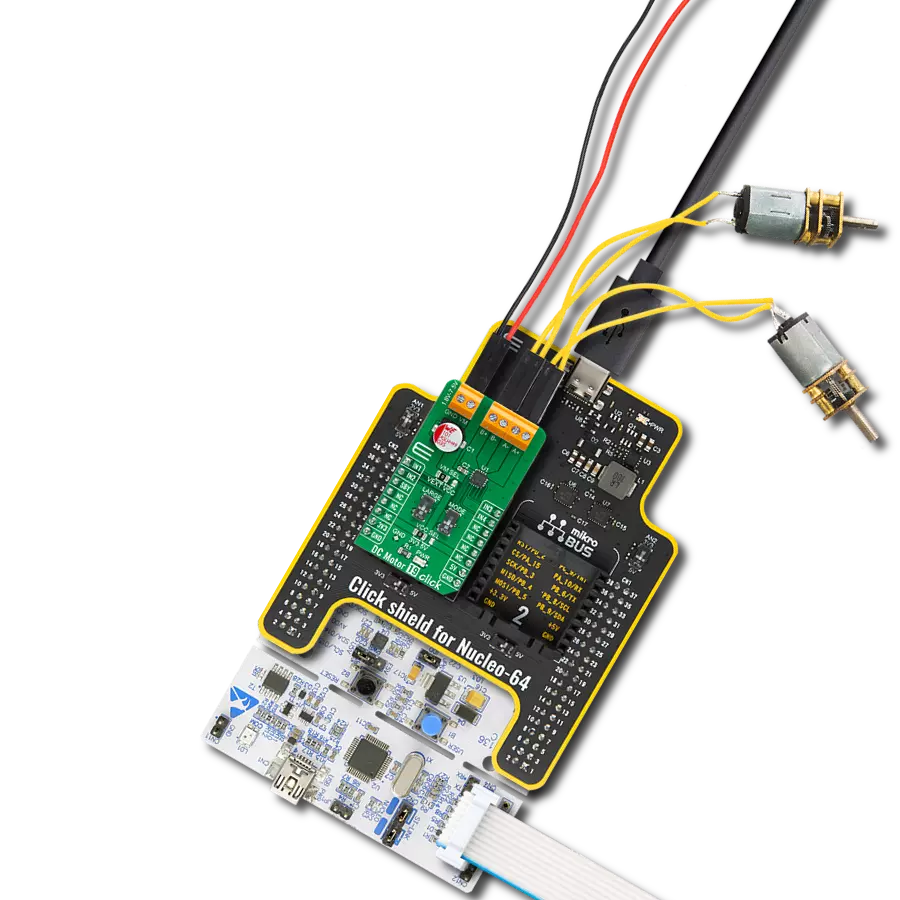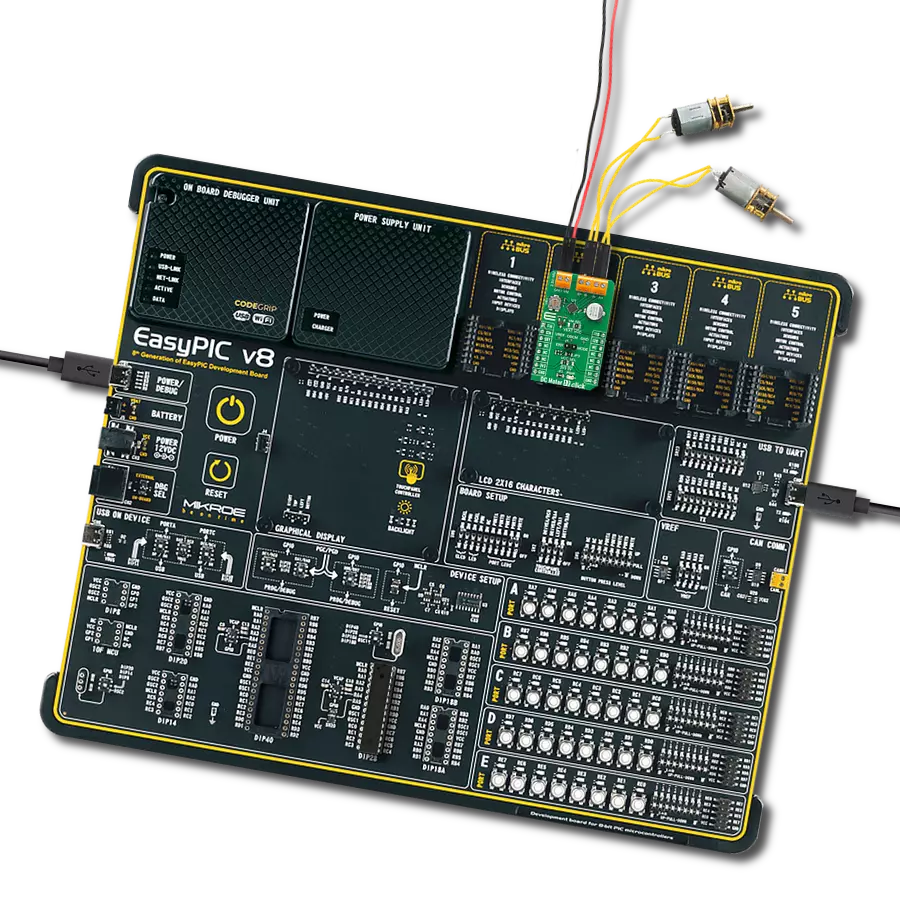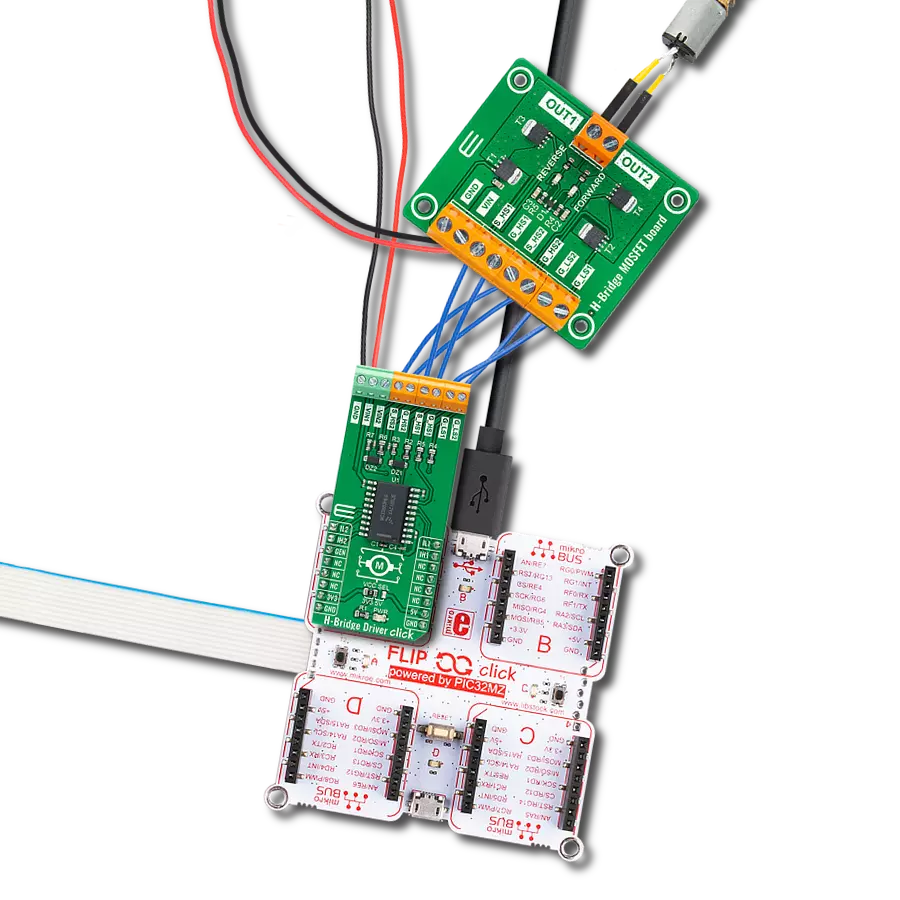Enhance your design, unlock the full potential of your DC motors, and attain versatile control across multiple operational modes
A
A
Hardware Overview
How does it work?
DC MOTOR 10 Click is based on the TLE 6208-6 G, a fully protected Hex-Half-Bridge-Driver explicitly designed for automotive and industrial motion control applications from Infineon Technologies. It integrates an efficient H-Bridge with a low ON resistance of approximately 0.8Ω through each branch. Furthermore, the built-in features like Over- and Undervoltage-Lockout, Over-Temperature-Protection, and the low quiescent current in standby mode open a wide range of automotive- and industrial applications. DC MOTOR 10 Click is ideally suited for the rapid development of various DC motor driving applications, including home appliances, printers, industrial equipment, mechatronic applications, and more. The part is based on Infineon Smart Power Technology SPT®, which
allows bipolar and CMOS control circuitry in accordance with DMOS power devices existing on the same monolithic circuitry. The six low and high-side drivers are freely configurable and can be controlled separately. Therefore all kinds of loads can be combined. In motion control, up to 5 actuators (DCMotors) can be connected to the six half-bridge outputs (cascade configuration). Operation modes forward (CW), reverse (CCW), brake, and high impedance are controlled from a standard SPI-Interface. Controlling the outputs via software from a central logic allows for limiting power dissipation. The internal logic of TLE 6208-6 G is supplied by the VCC voltage, typical with 5V. The VCC voltage uses an internally generated Power-On Reset (POR) to initialize
the module at Power-on. The advantage of this system is that information stored in the logic remains intact in the event of short-term failures in the supply voltage VS. The system can therefore continue to operate following VS undervoltage without having to be reprogrammed. The undervoltage information is stored and can be read out via the interface. This Click board™ can only be operated with a 5V logic voltage level. The board must perform appropriate logic voltage level conversion before using MCUs with different logic levels. However, the Click board™ comes equipped with a library containing functions and an example code that can be used as a reference for further development.
Features overview
Development board
Nucleo-64 with STM32L073RZ MCU offers a cost-effective and adaptable platform for developers to explore new ideas and prototype their designs. This board harnesses the versatility of the STM32 microcontroller, enabling users to select the optimal balance of performance and power consumption for their projects. It accommodates the STM32 microcontroller in the LQFP64 package and includes essential components such as a user LED, which doubles as an ARDUINO® signal, alongside user and reset push-buttons, and a 32.768kHz crystal oscillator for precise timing operations. Designed with expansion and flexibility in mind, the Nucleo-64 board features an ARDUINO® Uno V3 expansion connector and ST morpho extension pin
headers, granting complete access to the STM32's I/Os for comprehensive project integration. Power supply options are adaptable, supporting ST-LINK USB VBUS or external power sources, ensuring adaptability in various development environments. The board also has an on-board ST-LINK debugger/programmer with USB re-enumeration capability, simplifying the programming and debugging process. Moreover, the board is designed to simplify advanced development with its external SMPS for efficient Vcore logic supply, support for USB Device full speed or USB SNK/UFP full speed, and built-in cryptographic features, enhancing both the power efficiency and security of projects. Additional connectivity is
provided through dedicated connectors for external SMPS experimentation, a USB connector for the ST-LINK, and a MIPI® debug connector, expanding the possibilities for hardware interfacing and experimentation. Developers will find extensive support through comprehensive free software libraries and examples, courtesy of the STM32Cube MCU Package. This, combined with compatibility with a wide array of Integrated Development Environments (IDEs), including IAR Embedded Workbench®, MDK-ARM, and STM32CubeIDE, ensures a smooth and efficient development experience, allowing users to fully leverage the capabilities of the Nucleo-64 board in their projects.
Microcontroller Overview
MCU Card / MCU
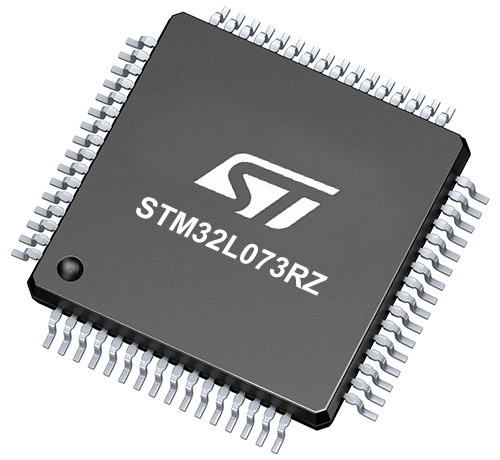
Architecture
ARM Cortex-M0
MCU Memory (KB)
192
Silicon Vendor
STMicroelectronics
Pin count
64
RAM (Bytes)
20480
You complete me!
Accessories
Click Shield for Nucleo-64 comes equipped with two proprietary mikroBUS™ sockets, allowing all the Click board™ devices to be interfaced with the STM32 Nucleo-64 board with no effort. This way, Mikroe allows its users to add any functionality from our ever-growing range of Click boards™, such as WiFi, GSM, GPS, Bluetooth, ZigBee, environmental sensors, LEDs, speech recognition, motor control, movement sensors, and many more. More than 1537 Click boards™, which can be stacked and integrated, are at your disposal. The STM32 Nucleo-64 boards are based on the microcontrollers in 64-pin packages, a 32-bit MCU with an ARM Cortex M4 processor operating at 84MHz, 512Kb Flash, and 96KB SRAM, divided into two regions where the top section represents the ST-Link/V2 debugger and programmer while the bottom section of the board is an actual development board. These boards are controlled and powered conveniently through a USB connection to program and efficiently debug the Nucleo-64 board out of the box, with an additional USB cable connected to the USB mini port on the board. Most of the STM32 microcontroller pins are brought to the IO pins on the left and right edge of the board, which are then connected to two existing mikroBUS™ sockets. This Click Shield also has several switches that perform functions such as selecting the logic levels of analog signals on mikroBUS™ sockets and selecting logic voltage levels of the mikroBUS™ sockets themselves. Besides, the user is offered the possibility of using any Click board™ with the help of existing bidirectional level-shifting voltage translators, regardless of whether the Click board™ operates at a 3.3V or 5V logic voltage level. Once you connect the STM32 Nucleo-64 board with our Click Shield for Nucleo-64, you can access hundreds of Click boards™, working with 3.3V or 5V logic voltage levels.
DC Gear Motor - 430RPM (3-6V) represents an all-in-one combination of a motor and gearbox, where the addition of gear leads to a reduction of motor speed while increasing the torque output. This gear motor has a spur gearbox, making it a highly reliable solution for applications with lower torque and speed requirements. The most critical parameters for gear motors are speed, torque, and efficiency, which are, in this case, 520RPM with no load and 430RPM at maximum efficiency, alongside a current of 60mA and a torque of 50g.cm. Rated for a 3-6V operational voltage range and clockwise/counterclockwise rotation direction, this motor represents an excellent solution for many functions initially performed by brushed DC motors in robotics, medical equipment, electric door locks, and much more.
Used MCU Pins
mikroBUS™ mapper
Take a closer look
Click board™ Schematic

Step by step
Project assembly
Software Support
Library Description
This library contains API for DC Motor 10 Click driver.
Key functions:
void dcmotor10_resetStatusReg();- Function is used to reset status register.void dcmotor10_enableChann1();- Function is used to enable channel 1.void dcmotor10_sendCommand( uint16_t wrData );- Function is used to send command.
Open Source
Code example
The complete application code and a ready-to-use project are available through the NECTO Studio Package Manager for direct installation in the NECTO Studio. The application code can also be found on the MIKROE GitHub account.
/*!
* \file
* \brief DcMotor10 Click example
*
* # Description
* This example is running dc motors on channels 1 through 3.
*
* The demo application is composed of two sections :
*
* ## Application Init
* Initalizes SPI, Click drivers and uninhibites the device.
*
* ## Application Task
* This example demonstrates the use of DC MOTOR 10 Click by running dc motors
* on channels 1 through 3, first all 3 together and then separately.
*
* \author Jovan Stajkovic
*
*/
// ------------------------------------------------------------------- INCLUDES
#include "board.h"
#include "log.h"
#include "dcmotor10.h"
// ------------------------------------------------------------------ VARIABLES
static dcmotor10_t dcmotor10;
static log_t logger;
// ------------------------------------------------------ APPLICATION FUNCTIONS
void application_init ( void )
{
log_cfg_t log_cfg;
dcmotor10_cfg_t cfg;
/**
* Logger initialization.
* Default baud rate: 115200
* Default log level: LOG_LEVEL_DEBUG
* @note If USB_UART_RX and USB_UART_TX
* are defined as HAL_PIN_NC, you will
* need to define them manually for log to work.
* See @b LOG_MAP_USB_UART macro definition for detailed explanation.
*/
LOG_MAP_USB_UART( log_cfg );
log_init( &logger, &log_cfg );
log_info( &logger, "---- Application Init ----" );
// Click initialization.
dcmotor10_cfg_setup( &cfg );
DCMOTOR10_MAP_MIKROBUS( cfg, MIKROBUS_1 );
dcmotor10_init( &dcmotor10, &cfg );
Delay_ms ( 100 );
dcmotor10_inhibit(&dcmotor10, DCMOTOR10_UNINHIBIT );
dcmotor10_send_cmd( &dcmotor10, DCMOTOR10_RESET_STATUS_REG );
Delay_ms ( 100 );
}
void application_task ( void )
{
dcmotor10_send_cmd( &dcmotor10, DCMOTOR10_ENABLE_1 | DCMOTOR10_ENABLE_2
| DCMOTOR10_ENABLE_3 );
Delay_ms ( 1000 );
Delay_ms ( 1000 );
Delay_ms ( 1000 );
Delay_ms ( 1000 );
Delay_ms ( 1000 );
dcmotor10_send_cmd( &dcmotor10, DCMOTOR10_ENABLE_1 );
Delay_ms ( 1000 );
Delay_ms ( 1000 );
Delay_ms ( 1000 );
Delay_ms ( 1000 );
Delay_ms ( 1000 );
dcmotor10_send_cmd( &dcmotor10, DCMOTOR10_ENABLE_2 );
Delay_ms ( 1000 );
Delay_ms ( 1000 );
Delay_ms ( 1000 );
Delay_ms ( 1000 );
Delay_ms ( 1000 );
dcmotor10_send_cmd( &dcmotor10, DCMOTOR10_ENABLE_3 );
Delay_ms ( 1000 );
Delay_ms ( 1000 );
Delay_ms ( 1000 );
Delay_ms ( 1000 );
Delay_ms ( 1000 );
dcmotor10_send_cmd( &dcmotor10, DCMOTOR10_RESET_STATUS_REG );
Delay_ms ( 1000 );
}
int main ( void )
{
/* Do not remove this line or clock might not be set correctly. */
#ifdef PREINIT_SUPPORTED
preinit();
#endif
application_init( );
for ( ; ; )
{
application_task( );
}
return 0;
}
// ------------------------------------------------------------------------ END
Additional Support
Resources
Category:Brushed
